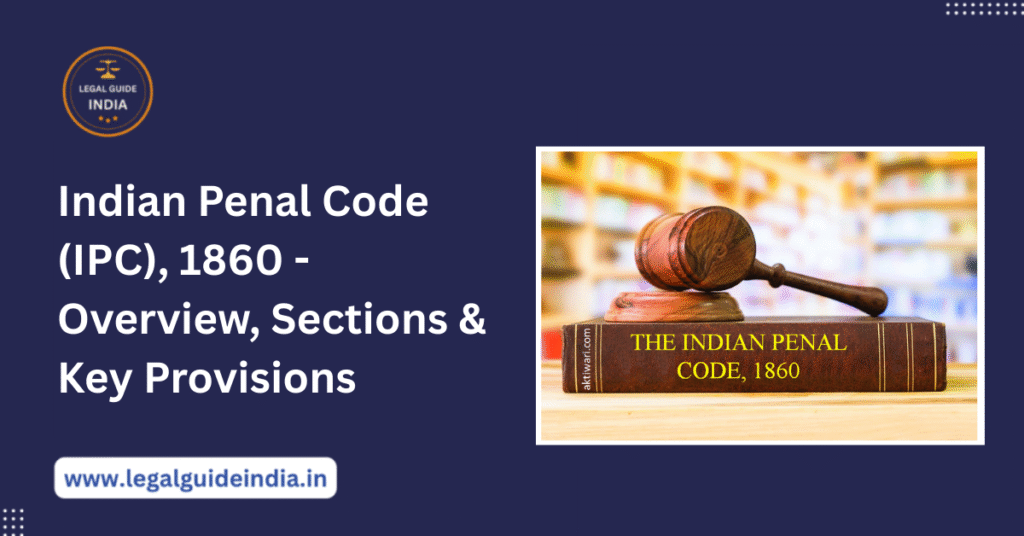The Indian Penal Code (IPC) is the backbone of India’s criminal justice system. Enacted in 1860 during the British era, it defines various crimes, punishments, and procedures under Indian law. Even after more than 160 years, the IPC remains the primary criminal code of India, though it has undergone several amendments to meet modern legal and social needs.
If you want to understand what IPC is, its sections, history, and importance, this guide covers everything in detail.
What is IPC?
The Indian Penal Code (IPC), 1860 is a comprehensive set of laws that classify different types of crimes in India and prescribe punishments for them. It covers crimes like theft, murder, assault, defamation, cheating, fraud, rape, dowry deaths, and cybercrimes.
In simple terms, IPC defines:
- General principles of criminal liability.
- What acts are considered crimes in India.
- What punishments or penalties those crimes attract.
For more than 160 years, IPC acted as the central criminal code in India. Even though the IPC has now been replaced by the Bharatiya Nyaya Sanhita (BNS) 2023, its legacy remains significant in understanding the evolution of criminal justice in India.
History and Background of IPC
The IPC was drafted by Lord Thomas Babington Macaulay along with the first Law Commission of India in 1834. It came into force in 1862, after India was placed under direct British rule.
Before Indian Penal Code, criminal laws in India were inconsistent — based on customs, personal laws, and scattered colonial regulations. The aim of the IPC was to provide a uniform, codified, and comprehensive criminal law system.
Some important facts about IPC history:
- IPC enactment year: 1860
- IPC enforcement date: 1862
- Drafted by: Lord Macaulay and team
- Replaced by: Bharatiya Nyaya Sanhita (BNS) in 2024
Thus, IPC became one of the world’s earliest modern criminal codes, serving as a model for several Asian and African countries.
Objectives and Purpose of the IPC
The objectives of IPC were clear and practical:
- To define offences clearly so that every citizen knows what constitutes a crime.
- To provide punishments proportionate to offences.
- To maintain law and order in Indian society.
- To ensure equal treatment under law, irrespective of class, caste, or religion.
In simple terms, Indian Penal Code was introduced to bring clarity, fairness, and uniformity to the criminal justice system of India.
Structure and Classification of IPC
The Indian Penal Code 1860 was divided into 23 chapters and 511 sections (often referred to as IPC dhara in Hindi). Many people search for “IPC sections list PDF” or the “IPC bare act” to study the complete code. This structured approach made IPC a comprehensive criminal law code.
Classification of IPC sections:
- General principles – definitions, exceptions, and explanations.
- Offences against the State – sedition, waging war.
- Offences against human body – murder, rape, kidnapping, assault.
- Offences against property – theft, robbery, fraud, misappropriation.
- Offences relating to documents, trade, marriage, and elections.
- Attempts and abetments – attempt to commit crime and conspiracies.
Important Sections of IPC
Over the years, some Indian Penal Code sections became especially significant due to frequent use:
- Section 302 – Punishment for murder (death penalty or life imprisonment).
- Section 375 & 376 – Definition of rape and punishment.
- Section 420 – Cheating and dishonestly inducing delivery of property.
- Section 498A – Cruelty by husband or relatives (dowry harassment cases).
- Section 377 – (Earlier) unnatural offences; now partially decriminalized.
- Section 124A – Sedition (currently under legal review).
- Section 509 – Word, gesture, or act intended to insult the modesty of a woman.
Offences and Punishments under IPC
The IPC offences were wide-ranging, covering crimes against individuals, society, and the State.
The Indian Penal Code punishment chart provided five main types of punishments:
- Death penalty (used rarely, for heinous crimes like terrorism or brutal murders).
- Life imprisonment (for crimes like murder, rape in aggravated cases).
- Rigorous imprisonment (with hard labour).
- Simple imprisonment (without labour).
- Fine or forfeiture of property.
This ensured a graded punishment system, where the severity of the penalty matched the seriousness of the crime.
General Explanations and Exceptions
The general explanations under IPC clarify definitions like:
- Meaning of offence
- Concept of person, public servant, or movable property
The General Exceptions in IPC protected individuals from liability in cases where criminal intent was missing. Examples include:
- Section 84 IPC – acts of a person of unsound mind (insanity defence).
- Accidents done without criminal intention.
- Acts of minors under a certain age.
- Acts done under legal compulsion or necessity.
These provisions ensured justice with fairness, preventing innocent people from being punished.
IPC vs CrPC vs Evidence Act
Many people confuse these three important laws. Here’s the difference:
- IPC (Indian Penal Code): Defines crimes and punishments.
- CrPC (Code of Criminal Procedure): Explains how trials and investigations are conducted.
- Indian Evidence Act: Deals with rules of evidence during trials.
Together, these three form the foundation of Indian criminal law.
Amendments and Recent Changes in IPC
Since its introduction, the IPC went through several amendments to stay relevant. New provisions were added for acid attacks, dowry deaths, cybercrime, and sexual harassment.
However, critics argued that the IPC language was colonial, outdated, and often misused. For example, Section 377 (criminalizing homosexuality) remained until it was struck down by the Supreme Court in 2018.
Finally, in 2023, the Indian Penal Code was replaced by Bharatiya Nyaya Sanhita (BNS). The BNS came into effect on July 1, 2024, modernizing Indian criminal law with simplified language, updated punishments, and new provisions.
Criticism and Limitations of IPC
While IPC was revolutionary in the 19th century, by the 21st century it faced several challenges:
- Colonial roots: Drafted by the British with a colonial mindset.
- Complexity: Overlapping and confusing sections.
- Delay in reforms: Modern crimes like cyber fraud were not covered initially.
- Misuse of certain sections: e.g., sedition laws and religious offence sections.
These limitations highlighted the need for a new criminal code in India, which led to IPC being replaced by BNS.
Importance and Impact of IPC in Indian Society
Even though it has been replaced by BNS, the IPC remains a landmark in India’s legal history.
Significance of IPC:
- It acted as the legal backbone of Indian criminal law for over 160 years.
- Provided uniformity across diverse communities and regions.
- Shaped India’s judicial judgments and police procedures.
- Ensured that every citizen understood the meaning of IPC offences and punishments.
Even today, lawyers and students continue to study IPC to understand the roots of India’s legal system.
FAQs on IPC (Indian Penal Code)
Q1. What does IPC mean?
IPC means Indian Penal Code, the criminal law code drafted in 1860 to define offences and punishments in India.
Q2. Who wrote the Indian Penal Code?
The IPC was drafted by Lord Thomas Babington Macaulay and the First Law Commission of India in 1834.
Q3. How many IPC sections are there?
The IPC had 511 sections across 23 chapters, though some were repealed or amended over time.
Q4. When did IPC come into force?
The IPC was enacted in 1860 and came into force on January 1, 1862 across British India.
Q5. Why was IPC replaced by BNS?
IPC was considered outdated, complex, and colonial in nature. To address modern crimes and simplify the law, it was replaced by the Bharatiya Nyaya Sanhita (BNS) 2023.
Q6. What are the important IPC sections?
Some commonly cited IPC sections include Section 302 (murder), Section 376 (rape), Section 420 (cheating), and Section 295A (hurting religious sentiments).
Q7. Can IPC be amended?
Yes. Over the years, IPC was amended multiple times. For instance, laws on dowry, sexual harassment, and acid attacks were later added.
Q8. Is IPC part of the Constitution?
No, IPC is not part of the Constitution. It is a criminal law code enacted separately in 1860, but it works alongside constitutional provisions of justice.
Useful Links
Conclusion
The Indian Penal Code (IPC), enacted in 1860, laid the foundation of India’s criminal justice system. It defined crimes, punishments, and exceptions, bringing clarity and uniformity to law and order. While the IPC is now replaced by the Bharatiya Nyaya Sanhita (BNS), its historical significance, structure, and influence on Indian law remain unmatched. For law students, professionals, and citizens, understanding IPC is essential to appreciating the roots of justice in India.




Pingback: Ahmedabad School Stabbing: Class 10 Student Attacks Junior
Pingback: Umar Khalid Bail Plea Rejected by Delhi High Court: Next Step Supreme Court - Legal Guide India
Pingback: Tension Erupts in Manipur: Legal & Social Fallout of Churachandpur Vandalism - Legal Guide India
Pingback: Raipur Nude Party Posters: Legal, Social & Political Fallout - Legal Guide India